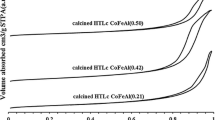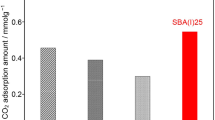Abstract
Mesoporous amino-functionalized adsorbents for post-combustion CO2 capture were synthesized by grafting and sol–gel methods. The silsesquioxane obtained by polycondensation of bis[3-(trimethoxysilyl)-propyl]amine without a cross-linker had the highest amount of surface amino groups. Their content was 8.4 times higher than in the grafted material prepared with the same precursor. All obtained materials were tested in CO2 reversible adsorption from a gas stream. The bridged silsesquioxane adsorbent had the adsorption capacity 4.7 times higher than the grafted sample obtained from the same precursor. Porosity study of this material revealed wide pore size distribution with notable fraction of macropores. The nature of adsorbed species was determined from the FTIR spectrum after adsorption. It was found that CO2 formed carbamate and bicarbonate species on the surface.
Graphical Abstract





Similar content being viewed by others
References
Gray ML, Soong Y, Champagne KJ, Pennline H, Baltrus JP, Stevens RW, Khatri R, Chuang SSC, Filburn T (2005) Improved immobilized carbon dioxide capture sorbents. Fuel Process Technol 86:1449–1455
Choi S, Drese JH, Jones CW (2009) Adsorbent materials for carbon dioxide capture from large anthropogenic point sources. ChemSusChem 2:796–854
Abu-Khader MM (2006) Recent progress in CO2 capture/sequestration: a review. Energy Source Part A 28:1261–1279
Rao AB (2007) Technologies: separation and capture. In: Wilson EJ, Gerard D (eds) Carbon capture and sequestration: integrating technology, monitoring, regulation. Wiley, Weinheim
Schrag DP (2007) Preparing to capture carbon. Science 315:812–813
Steeneveldt R, Berger B, Torp TA (2006) CO2 capture and storage: closing the knowing-doing gap. Chem Eng Res Design 84:739–763
Yang HQ, Xu ZH, Fan MH, Gupta R, Slimane RB, Bland AE, Wright I (2008) Progress in carbon dioxide separation and capture: a review. J Environ Sci China 20:14–27
Benson SM, Orr FM (2008) Carbon dioxide capture and storage. MRS Bull 33:303–305
Dumée L, Scholes C, Stevens G, Kentish S (2012) Purification of aqueous amine solvents used in post combustion CO2 capture: a review. Int J Greenh Gas Con 10:443–455
Ma’mun S, Svendsen HF, Hoff KA, Juliussen O (2006) Selection of new absorbents for carbon dioxide capture. Energy Convers Manag 48:251–258
Shao R, Stangeland A (2009) Amines used in CO2 capture—health and environmental impacts. Belonna Report Sept 2009, The Bellona Foundation, Oslo
Gray ML, Soong Y, Champagne KJ, Pennline HW, Baltrus J, Stevens RW, Khatri R, Chuang SC (2004) Capture of carbon dioxide by solid amine sorbents. Int J Environ Technol Manag 4:82–88
Hiyoshi N, Yogo K, Yashima T (2004) Adsorption of carbon dioxide on amine modified SBA-15 in the presence of water vapor. Chem Lett 33:510–511
Huang HY, Yang RT, Chinn D, Munson CL (2003) Amine-grafted MCM-48 and silica xerogel as superior sorbents for acidic gas removal from natural gas. Ind Eng Chem Res 42:2427–2433
Zheng F, Tran DN, Busche BJ, Fryxell GE, Addleman RS, Zemanian TS, Aardahl CL (2005) Ethylenediamine-modified SBA-15 as regenerable CO2 sorbent. Ind Eng Chem Res 44:3099–3105
Husing N (2007) Porous hybrid materials. In: Kickelbick G (ed) Hybrid materials: synthesis, characterization, and applications. Wiley, Weinheim
Loy DA (2007) Sol-gel processing of hybrid organic-inorganic materials based on polysilsesquioxanes. In: Kickelbick G (ed) Hybrid materials: synthesis, characterization, and applications. Wiley, Weinheim
Sanchez C, Julian B, Belleville P, Popall M (2005) Applications of hybrid organic-inorganic nanocomposites. J Mater Chem 15:3559–3592
Stein A, Melde BJ, Schroden RC (2000) Hybrid inorganic-organic mesoporous silicates—nanoscopic reactors coming of age. Adv Mater 12:1403–1419
Bollini P, Didas SA, Jones CW (2011) Amine-oxide hybrid materials for acid gas separations. J Mater Chem 21:15100–15120
Hoffmann F, Cornelius M, Morell J, Froba M (2006) Silica-based mesoporous organic–inorganic hybrid materials. Angew Chem Int Ed 45:3216–3251
Vasiliev AN, Golovko LV, Trachevsky VV, Hall GS, Khinast JG (2009) Adsorption of heavy metal cations by organic ligands grafted on porous materials. Micropor Mesopor Mater 118:251–257
Vassylyev O, Chen J, Panarello AP, Khinast JG (2005) Catalytic properties of several supported Pd(II) complexes for Suzuki coupling reactions. Tetrahedron Lett 46:6865–6869
Hicks JC, Drese JH, Fauth DJ, Gray ML, Qi G, Jones CW (2008) Designing adsorbents for CO2 capture from flue gas—hyperbranched aminosilicas capable of capturing CO2 reversibly. J Am Chem Soc 130:2902–2903
Drese JH, Choi S, Lively RP, Koros WJ, Fauth DJ, Gray ML, Jones CW (2009) Synthesis–structure–property relationships for hyperbranched aminosilica CO2 adsorbents. Adv Funct Mater 19:3821–3832
Choi S, Drese JH, Eisenberger PM, Jones CW (2011) Application of amine-tethered solid sorbents for direct CO2 capture from the ambient air. Environ Sci Technol 45:2420–2427
Chaikittisilp W, Kim H-J, Jones CW (2011) Mesoporous alumina-supported amines as potential steam-stable adsorbents for capturing CO2 from simulated flue gas and ambient air. Energy Fuels 25:5528–5537
Husing N (2004) Porous inorganic-organic hybrid materials. In: Gómez-Romero P, Sánchez C (eds) Functional hybrid materials. Wiley, Weinheim
Macquarrie DJ, Rousseau H (2003) High-loading aminopropyl silicas as novel scavenger resins for high throughput synthesis. Synlett 2:244–246
Mdoe JEG, Macquarrie DJ, Clark JH (2003) One-pot preparation of polyamine–silica hybrids and their use in the epoxidation of cyclohex-2-ene-1-one. J Mol Catal A Chem 198:241–247
Loy DA, Shea KJ (1995) Bridged polysilsesquioxanes. Highly porous hybrid organic-inorganic materials. Chem Rev 95:1431–1442
Asefa T, MacLachlan MJ, Coombs N, Ozin GA (1999) Periodic mesoporous organosilicas with organic groups inside the channel walls. Nature 402:867–871
Inagaki S, Guan S, Fukushima Y, Ohsuna T, Terasaki O (1999) Novel mesoporous materials with a uniform distribution of organic groups and inorganic oxide in their frameworks. J Am Chem Soc 121:9611–9614
Hunks WJ, Ozin GA (2005) Challenges and advances in the chemistry of periodic mesoporous organosilicas (PMOs). J Mater Chem 15:3716–3724
Mehdi A, Reye C, Corriu R (2011) From molecular chemistry to hybrid nanomaterials. Design and functionalization. Chem Soc Rev 40:563–574
Zhou G, Simerly T, Golovko L, Tychinin I, Trachevsky V, Gomza Y, Vasiliev A (2012) Highly functionalized bridged silsesquioxanes. J Sol-Gel Sci Technol 62:470–482
Loy DA, Baugher BM, Baugher CR, Schneider DA, Rahimian K (2000) Substituent effects on the sol-gel chemistry of organotrialkoxysilanes. Chem Mater 12:3624–3632
Pal N, Bhaumik A (2013) Soft templating strategies for the synthesis of mesoporous materials: inorganic, organic–inorganic hybrid and purely organic solids. Adv Colloid Interface Sci 189–190:21–41
Díaz U, García T, Velty A, Corma A (2009) Hybrid organic–inorganic catalytic porous materials synthesized at neutral pH in absence of structural directing agents. J Mater Chem 19:5970–5979
Bernardoni F, Fadeev AY (2011) Adsorption and wetting characterization of hydrophobic SBA-15 silicas. J Colloid Interface Sci 356:690–698
Tanthana J, Chuang SSC (2010) In situ infrared study of the role of PEG in stabilizing silica-supported amines for CO2 capture. ChemSusChem 3:957–964
Fisher JC II, Tanthana J, Chuang SSC (2009) Oxide-supported tetraethylenepentamine for CO2 capture. Environ Prog Sustain Energy 28:589–598
Chang ACC, Chuang SSC, Gray M, Soong Y (2003) In-situ infrared study of CO2 adsorption on SBA-15 grafted with γ-(aminopropyl)triethoxysilane. Energy Fuels 17:468–473
Tsuda T, Fujiwara T, Taketani Y, Saegusa T (1992) Amino silica gels acting as a carbon dioxide absorbent. Chem Lett 21:2161–2164
Hao SY, Xiao QA, Yang H, Zhong YJ, Pepe F, Zhu WD (2010) Synthesis and CO2 adsorption property of amino-functionalized silica nanospheres with centrosymmetric radial mesopores. Micropor Mesopor Mater 132:552–558
Bacsik Z, Atluri R, Garcia-Bennett AE, Hedin N (2010) Temperature-induced uptake of CO2 and formation of carbamates in mesocaged silica modified with n-propylamines. Langmuir 26:10013–10024
Stegmeier S, Fleischer M, Tawil A, Hauptmann P, Egly K, Rose K (2009) Mechanism of the interaction of CO2 and humidity with primary amino group systems for room temperature CO2 sensors. Procedia Chem 1:236–239
Hiyoshi N, Yogo K, Yashima T (2005) Adsorption characteristics of carbon dioxide on organically functionalized SBA-15. Micropor Mesopor Mater 84:357–365
Khatri RA, Chuang SSC, Soong Y, Gray M (2005) Carbon dioxide capture by diamine-grafted SBA-15: a combined Fourier transform infrared and mass spectrometry study. Ind Eng Chem Res 44:3702–3708
Steiner T (2002) The hydrogen bond in the solid state. Angew Chem Int Ed 41:49–76
Jeffrey GA (1997) An introduction to hydrogen bonding. Oxford University Press, Oxford
Li Z, Zhang B (2012) Experimental and theoretical investigation of homogeneous gaseous reaction of CO2(g) + nH2O(g) + nNH3(g) → Products (n = 1,2). J Phys Chem A 116:8989–9000
Adams JM, Small RWH (1973) The crystal structure of ammonium carbamate. Acta Crystallogr B B29:2317–2319
Author information
Authors and Affiliations
Corresponding author
Rights and permissions
About this article
Cite this article
Esam, O., Zhou, G. & Vasiliev, A. Bridged mesoporous silsesquioxanes as potential CO2 adsorbents. J Sol-Gel Sci Technol 74, 740–747 (2015). https://doi.org/10.1007/s10971-015-3657-9
Received:
Accepted:
Published:
Issue Date:
DOI: https://doi.org/10.1007/s10971-015-3657-9




